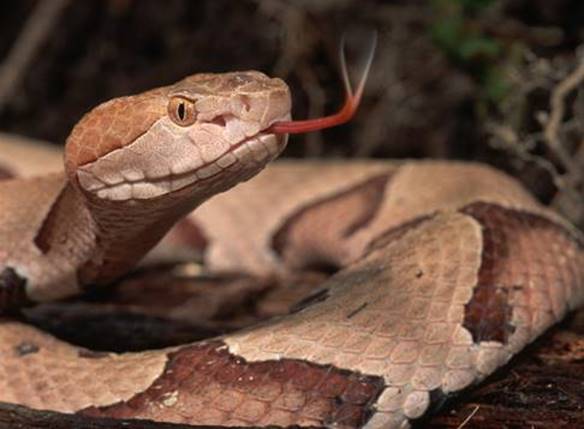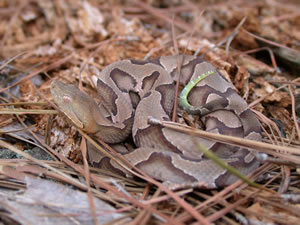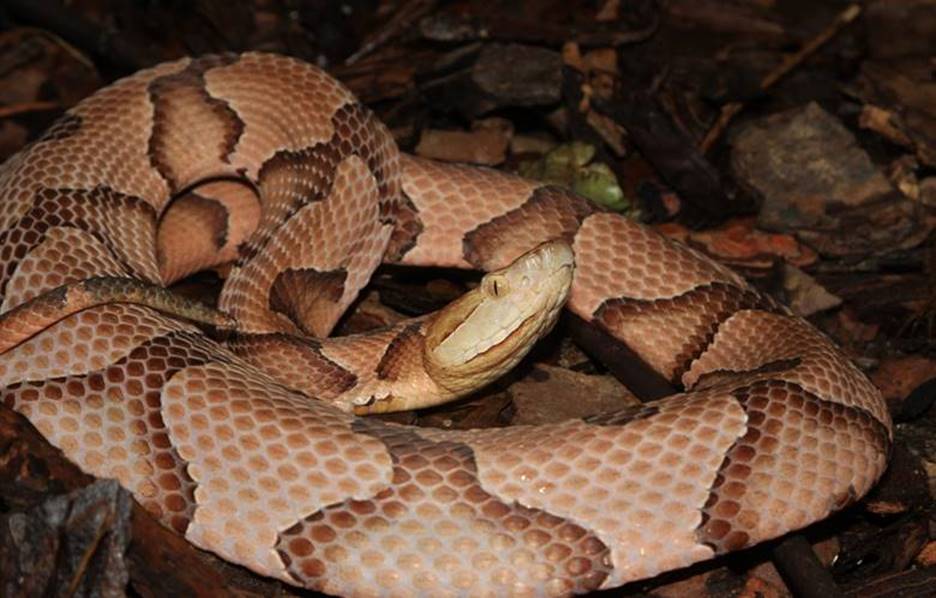Science and art should be mutual pathways to understanding: We need something to confront sensually, something about which to feel, in order to place value on nature; we need the opportunity to interpret, to reflect on our own experiences and those of others in the context of new details and new perspectives. –Dr. Harry W. Greene; Snakes: The Evolution of Mystery in Nature.
This is an especially attractive snake found from lower New York state south to northern Florida and west to Texas and northern Mexico. It is venomous. These are fairly large snakes 24 – 52 inches long with a heavy body and large triangular heads typical of North American vipers. Males weigh up to 12 ounces. They have elliptical, cat-like pupils, which make them look a bit spooky. Copperheads also are known as hunk head, highland moccasin (as opposed to water moccasin), or pilot snake, among other name.


They have a tan to brownish body with beautiful darker hourglass bands across the length of their body. It really is a striking looking snake. The head is solid brown with two tiny dots in the center-top of the head. Juveniles are similar to the adults but have a bright yellow tail tip. Males are larger than females. As pit-vipers they have facial pits that detect body heat – for finding prey and being aware of predators.

They can be confused with some common snakes, particularly the common water snake, which has a nasty disposition but is not venomous. Their habitat preferences are adaptable depending where in the range they occur. In some areas they are most common on dry rocky hillsides and sometimes communally den with timber rattlesnakes.
They are quite tolerant of habitat fragmentation – I found one on my front porch when I lived in a 150-yr-old house near Harpers Ferry W.VA. We moved it away from the house and Sawyer, our Chesapeake Bay Retriever. Copperheads can be found during the day or night but primarily forage in the evening during the warmer time of the year. They are often observed crossing or laying on roads in early evening – not a very wise decision. They are opportunistic feeders and consume a wide variety of prey including amphibians, lizards, snakes, small mammals, birds, and insects.
Agkistrodon – Greek ancistron, fishhook, in reference to the recurved fangs. Contortrix, Latin, contortus – twisted or intricate, in reference to the banding pattern.
They mate in the spring when the males will travel long distances in search of a female. These snakes give birth to up to 20 live young. The juvenile snakes will wiggle their brightly colored tails to lure in prey such as frogs and salamanders, called caudal luring.
Copperheads also can reproduce by way of facultative parthenogenesis whereby reproduction and growth and development of embryos can occur without fertilization. It is thought that this occurs through automatic with terminal fusion, where two terminal products form the same meiosis fuse to form a diploid zygote (if you are really interested – Parthenogenesis ). It is not particularly advantageous and can lead to in-breeding genetic concerns but may be useful in limited ways when mates are hard to find.
Because of their excellent camouflage and secretive ways, copperheads are responsible for the majority of venomous snake bites in the SE United States. Rattlesnakes will let you know if you are getting too close, but copperheads will sit silently nested in a tree root beside the trail and bite your ankle as you go by – or at least that’s the way I always thought of them.
Copperheads also will “freeze” if disturbed rather than silently slither away, which may lead to bites. Bites are rarely fatal but symptoms include extreme pain, tingling, throbbing, swelling and nausea. First bites may be “warning bites” where little venom is released, or a dry bite.
A fellow grad student, who grew up near the small town of Finzel in western MD, was always out catching things when he was a kid (that sounds familiar). His dad was always on him about watching out for rattlesnakes and copperheads. One day he went to pick up a small copperhead and got bit on the thumb. He was more worried about getting a whupping from his Pa so he ate his dinner with his thumb tucked in his fist and went to bed with a fever and nausea. He told his mom he was sick, got to stay home a couple days, and was fine.
Copperheads will, at times, exhibit a defensive tail vibration if approached closely. Both vipers and non-vipers will exhibit this behavior. It is thought to mimic, or be a foundational behavior trait similar to rattlesnakes shaking their tail.
In graduate school I regularly signed on to help our resident herpetology professor collecting herps (reptiles/amphibians). He asked my roomie and I if we would spend a late afternoon with him collecting copperheads. It was springtime and the ground was just warming up and he wanted to visit a copperhead den he knew of and collect a half dozen snakes for weight/measurements and later mark and release.
With the offer of some beer at the end of the day we said “Sure, we’re in!”.
We jumped in the truck the next day and headed out for the short drive to some nice oak-hickory forest in the Allegheny Mountains of western MD. We stomped up a steep forested slope for about 40 minutes and then Jim stopped us to give us the lay of the land. We were approaching a large rock outcrop and at the base was the den. But – heads up starting here. The copperheads are dispersing for the summer and could be anywhere around here.
We each had a snake tongs Grabbers which allow you to catch a venomous snake safely without harming it, and a heavy burlap bag. God these snakes are kind creepy!
They were so silent, just sitting there watching us while we are carefully, slowly stepping up towards the rocks, constantly scanning the ground. We fanned out over a 100-foot line and walked together up slope. And then – akkk! – there was one just a little too close. Like 5 feet away! How did I not see that thing sooner? Then you get a bit paranoid and do a quick glance at your feet and nearby to make sure none are CLOSER!
I paused before picking him up. It looked to be a large male, curled up against a dark granite stone and nestled well among dry leaves. It was about 3.5 feet long and thicker than my wrist at its middle. Its orange-ish eye and vertical pupil just stared. It didn’t move. I stared. I was struck with just how gorgeous an animal it was. Those precise and clean bands, the contrasting colors, how well it was hidden.
I snapped out of my wonderment.
“Got one” I alerted the others and tapped it with the end of the tong to make it stretch out a bit, squeezed the tongs on his body just below the neck, and dropped him in the bag. Now you had to pay attention to not carry the bag against your leg in case a lucky snake (you unlucky) poked a fang through the burlap.
We collected 8 snakes and that was enough, went back to the truck and placed the bags in separate 5 gallon buckets with snap lids, sat on the tailgate and cracked a couple beers before driving back to the lab.
A week later we were back to reverse the process. We popped open the bucket lids, pulled out and opened the bags, and encouraged the snakes to find their summer range. A minor stampede of 8 snakes dispersed in random directions up the slope. They were happy. We were happy.
